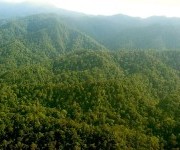So Copenhagen is over, with forests mentioned in one paragraph of a politically ambiguous “Copenhagen Accord” and an incomplete REDD agreement stapled on the back with major safeguard and finance issues still unresolved. Clearly, high hopes of a deal that might save the world’s forests and reduce the 15-20 percent of global greenhouse gas emissions from deforestation and degradation will have to wait, at least till next year’s December meeting of the UNFCCC in Mexico City, if not beyond.
So along with many other people, you might be wondering, what happens now for REDD and for the world’s tropical forests?
Not much it seems. Forests remain under threat for all the same reasons that we’ve historically cut them down — illegal logging, industrial agriculture expansion, and destructive “development” projects. At least for one more year, business as usual is certainly going to continue and tropical forests will probably continue to be lost at the shocking rate of one acre per second.
Things are going to keep moving, however.
The UNFCCC process will continue as the REDD working group meets again in Bonn in June to work out technical issues, hopefully starting where they’ve left off in Copenhagen and further strengthening key provisions rather than going back to square one. Political negotiations will continue at least through Mexico City — a continuation of the process that started in Bali.
As Kevin Conrad, executive director of the Coalition of Rainforest Nations, aptly put it to the AP:
“It’s depressing,” he said. “It means I’ve got to spend another year … coming to meetings and talking about the same things.”
Various other processes intended to address the rapid destruction of the world’s tropical forests will also continue, but without resolution of critical environmental and social safeguards (notably including recognition and respect for indigenous people’s rights) that a Copenhagen forest agreement might have provided. The most notable of these include the U.N.-REDD initiative, the World Bank Forest Carbon Partnership Facility, and new initiatives started to help countries with “REDD readiness” planning.
This proliferation of initiatives, plus the consideration of a U.S. Senate climate bill with its large REDD provisions linked to dodgy offset approaches, results in a divide and conquer approach for forest protection — keeping advocates of a more rights-centric and environmentally friendly approach sorely stretched.
But the most depressing fail for the forests out of Copenhagen is the lack of binding targets to reduce fossil fuel emissions and start to halt climate change. If global temperatures rise above 2 degrees C, most scientists predict that tropical forests will be profoundly affected, experiencing extreme droughts, increased forest fires and other catastrophic weather events. Even if a separate deal to reduce deforestation and forest degradation in developing countries had been agreed upon, the lack of commitment to deep fossil fuel emissions in a legally binding climate change agreement would continue to threaten the world’s forests.
We can’t save the forests if we don’t save the climate. And that means that REDD without a larger climate deal is no deal at all.



